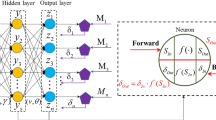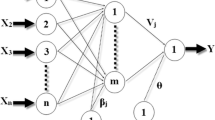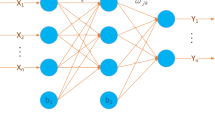Abstract
Roughness is an important property of wood surface and has a significant influence on the interface bonding strength and surface coating quality. At present, there is little research on theoretical models for poplar fine sanding. In this study, poplar wood was fine-sanded with an air drum. An orthogonal experiment was carried out to study the effects of abrasive grain size, feed rate, belt speed, air drum deformation and air drum pressure on the surface roughness of poplar wood. The simulation models of the longitudinal roughness and the lateral roughness of the sanding surface were established based on BP neural network optimized by genetic algorithm (GA-BP neural network), and verified by the experimental data. The results show that the influence of sanding parameters on longitudinal roughness and lateral roughness is similar. The order of influence is abrasive grain size > belt speed > feed speed > air drum deformation and air drum pressure. The longitudinal roughness and lateral roughness of the surface of the poplar can be well predicted by GA-BP neural network. The average relative error of the predicted longitudinal roughness and lateral roughness are 2.67% and 2.65%, respectively.






Similar content being viewed by others
References
Alves MCS, Santiago LFF, Gonçalves MTT, Valarelli ID, Varasquim FMFDA (2015) Effects of belt speed, pressure and grit size on the sanding of Pinus elliottii wood. Cerne 21(1):45–50
Bao X, Ying JH, Cheng F (2018) Research on neural network model of surface roughness in belt sanding process for Pinus koraiensis. Measurement 115:11–18
Benardos PG, Vosniakos GC (2002) Prediction of surface roughness in CNC face milling using neural networks and Taguchi’s design of experiments. Robot Comput Integr Manuf 18(5–6):343–354
Cui X, Guo J, Zheng J (2016) Optimization of geometry parameters for ceramic cutting tools in intermittent turning of hardened steel. Mater Des 92:424–437
Hazir E, Koc KH (2018) A modeling study to evaluate the quality of wood surface. Maderas Cienc Tecnol 20(4):691–702
Hiziroglu S, Salca EA (2012) Analysis of surface roughness of black alder as function of various processing parameters. Pro Ligno 8(2):68–79
Li X, Chen YG, Li L (2010) Abrasive belt sanding technology of wood-based panel. Wood Process Mach 3:44–48
Luo B (2015) Study on sanding force and optimal sanding parameters in the belt sanding process of wood materials. Beijing Forestry University, Beijing
Luo B, Li L, Liu H, Xu M, Xing F (2014a) Analysis of sanding parameters, sanding force, normal force, power consumption, and surface roughness in sanding wood-based panels. BioResources 9(4):7494
Luo B, Li L, Xu M, Liu H, Xing F (2014b) Analysis of static friction coefficient between work-piece and rubber belt in sanding wood-based panel. BioResources 9(4):7372
Marinescu I, Rowe B, Dimitrov B, Inasaki I (2004) Tribology of abrasive machining processes. J Manuf Sci Eng 126(4):6–10
Miao T, Li L (2014) Study on influencing factors of sanding efficiency of abrasive belts in wood materials sanding. Wood Res 59(5):835–842
Richter K, Feist WC, Knabe MT (1995) The effect of surface roughness on the performance of finishes. I: roughness characterization and stain performance. For Prod J 45(1):91–97
Saloni DE, Lemaster RL, Jackson SD (2005) Abrasive machining process characterization on material removal rate, final surface texture, and power consumption for wood. For Prod J 55(12):35–41
Shi MM, Lei YF (2015) Abrasive belt grinding quality of several solid wood and wood-based board. Wood Process Mach 3:41–45
Singh GP, Alphonsa J, Barhai PK, Rayjada PA, Raole PM, Mukherjee S (2006) Effect of surface roughness on the properties of the layer formed on AISI 304 stainless steel after plasma nitriding. Surf Coat Technol 20:5807–5811
Sofuoglu SD (2017) Determination of optimal machining parameters of massive wooden edge glued panels which is made of Scots pine (Pinus sylvestris L.) using Taguchi design method. Eur J Wood Prod 75:33–42
Song ZL, Guo GX (2003) Analysis of factors affecting surface roughness of medium density fiberboard. China Wood Based Panels 2:12–14
Tiryaki S, Hamzacebi C, Malkocoglu A (2015) Evaluation of process parameters for lower surface roughness in wood machining by using Taguchi design methodology. Eur J Wood Prod 73:537–545
Varasquim FMFDA, Alves MCS, Gonçalves MTT, Santiago LFF, Souza AJDD (2012) Influence of belt speed, grit sizes and pressure on the sanding of Eucalyptus grandis wood. Cerne 18(2):231–237
Wang BJ, Dai C, Ellis S (2007) Effect of veneer surface roughness and compressibility on plywood/LVL performance. International Symposium on Veneer Processing, Shanghai
Xu M, Li L, Luo B, Xing F (2015) Study on sanding force and sanding optimal parameters of Manchurian ash. Eur J Wood Prod 73(3):385–393
Acknowledgements
The project is supported by the key research and development plan of Changsha (no. Kq2004094) and Chinese Postdoctoral Station of Guangzhou Tech-long Packaging Machinery Co., Ltd. (no. 263805).
Author information
Authors and Affiliations
Corresponding author
Rights and permissions
About this article
Cite this article
Wu, X., Niu, H., Li, XJ. et al. Research on GA-BP neural network model of surface roughness in air drum sanding process for poplar. Eur. J. Wood Prod. 80, 477–487 (2022). https://doi.org/10.1007/s00107-021-01686-2
Received:
Accepted:
Published:
Issue Date:
DOI: https://doi.org/10.1007/s00107-021-01686-2




